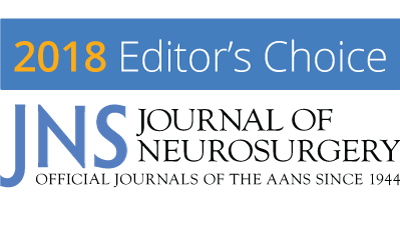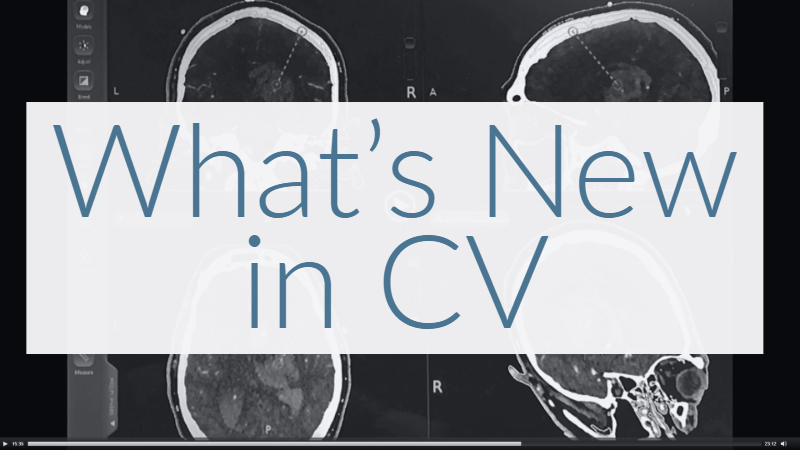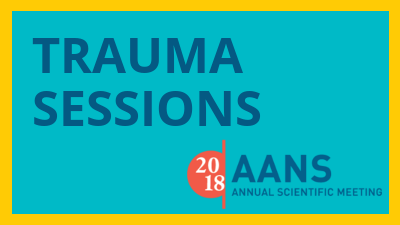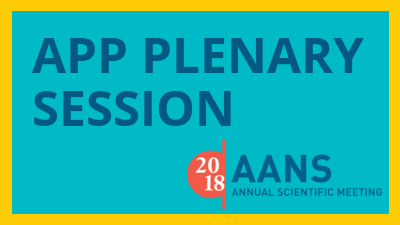Source: https://education.aans.org/online-education
-

<li>A standardization protocol to reduce pediatric baclofen pump infections: a quality improvement initiative</li><li>Introduction of severe traumatic brain injury care protocol is associated with reduction in mortality for pediatric patients</li><li>Online postconcussion return-to-play instructions</li><li>Traumatic brain injury in high versus low falls in young children and adolescents: a retrospective analysis</li><li>Complications follow a pediatric cranioplasty after decompressive craniectomy: a multicenter retrospective study</li><li>Motorcycle helmets and cervical spine injuries: a 5-year experience at a Level 1 trauma center</li><li>Subdural hematoma as a major determinant of short-term outcomes in traumatic brain injury</li><li>Surgical management of penetrating spinal cord injury primarily due to shrapnel and its effect on neurological outcome: a literature review and meta-analysis</li><li>Pediatric cerebral venous sinus thrombosis or compression in the setting of skull fractures from blunt head trauma</li><li>Effect of concussion history on symptom burden and recovery following pediatric sports-related concussion</li><li>Pediatric blunt cerebrovascular injury: the McGovern screening score</li><li>Simplifying the use of prognostic information in traumatic brain injury. Part 1: GCS-Pupils score: an extended index of clinical severity</li><li>Prospective comparison of long-term pain relief rates after first-time microvascular decompression and stereotactic radiosurgery for trigeminal neuralgia</li><li>Deep brain stimulation for intractable neuropathic facial pain</li><li>The relationship of dose to nerve volume in predicting pain recurrence after stereotactic radiosurgery in trigeminal neuralgia</li><li>CME Quiz</li><li>Evaluation</li><li>CME Certificate</li></ul>” data-html=”true” data-placement=”top” href=”#” title=”Components :”>Contains 18 Component(s), 15 credits offered
This online course will showcase a selection of the most significant articles from the 2018 issues of the Journal of Neurosurgery. Members: Free | Non-members: $179
-

<li>What’s New for Cerebral Aneurysms</li><li>Aneurysmal Subarachnoid Hemorrhage – Update</li><li>dAVF – What’s New?</li><li>Acute Ischemic Stroke</li><li>Intracranial Atherosclerosis ICAD</li><li>Carotid Surgery Update</li><li>Intracerebral Hemorrhage</li><li>An Update on Cerebral Cavernous Malformations</li><li>AVMs – Management Update</li><li>EC-IC Bypass Moya Moya</li><li>Quiz</li><li>Evaluation</li><li>Certificate</li></ul>” data-html=”true” data-placement=”top” href=”#” title=”Components :”>Contains 13 Component(s), 3.5 credits offered
An update on new developments in management of cerebrovascular disease, such as aneurysms, ischemic and hemorrhagic stroke, carotid disease, vascular malformations and moyamoya. AANS Members: $99 | Non-members: $139
-

<li>New Targets for DBS for Movement Disorders</li><li>Neurosurgery for OCD: Stimulation or Ablation?</li><li>Deep Brain Stimulation of the Superolateral Medial Forebrain Bundle (sIMFB-DBS) in Depression</li><li>Epilepsy Surgery in Africa: The Moroccan Experience</li><li> Individualizing Surgery for Patients with Spasticity</li><li>Stereotactic and Functional Neurosurgery in Developing Countries: Experience of Niger</li><li>Pathological Network in Essential Tremor and Surgical Implications</li><li>Stereotactic and Functional Panel/Case Discussions</li><li>Medulloblastomas in the Era of Molecular Biology: A Challenge for Developing Countries</li><li>Radionuclide Shuntography for the Evaluation of Ventriculo_Peritoneal Shunt in Children with Hydrocephalus</li><li>Intramedullary Spinal Cord Tumours – Astrocytomas</li><li>Modeling Neurological Diseases Using Stem Cell Technology</li><li>CVJ Anomalies and Skeletal Dysplasias in Children</li><li>Outcome of Combined Endoscopic Third Ventriculostomy + Choroid Plexus Cauterization in Childhood Hydrocephalus</li><li>Brain Tumors in Teens _ How to Deal with Strange Pathological Findings</li><li>Match Making in Global Pediatric Neurosurgery</li><li>Pediatric Panel/Case Discussions</li><li>Individualized Treatment of TBI in the Era of Precision Medicine</li><li>Biomarkers of TBI: Where (and Why) Do We Stand?</li><li>Update on Surgical Trials in Traumatic Brain Injury</li><li>Guidelines for TBI: Time for Change?</li><li>Threshold of Postoperative ICP Necessary for Better Than Vegetative Outcome After Decompressive Craniectomy for Severe Traumatic Brain Injuries</li><li>Outcome Predictions in Mild TBI</li><li>The Enigma of Chronic Subdural Hematomas in Africa</li><li>The International Initiative for Traumatic Brain Injury Research (InTBIR)</li><li>Introduction</li><li>Controversies in the Management of the Thoraco_lumbar Pott’s Disease </li><li>SCIWORA in Children</li><li>Subaxial Cervical Trauma in Adults</li><li>Prevalence of Concomitant Traumatic Cranio-spinal Injury! A systematic Review and Meta-Analysis</li><li>Craniocervical Junction Trauma</li><li>Shifting Paradigms in the Surgical Treatment of Cervical Spine Degenerative Disease Related to Age</li><li>Risk of Cement Leakage and Pulmonary Embolism by Bone Cement Augmented Pedicle Screw Fixation of the Thoracolumbar Spine</li><li>Regenerative and Reconstructive Approaches to the Lumbar Disc</li><li>Spine Panel/Case Discussions</li><li>Tears and Smiles in Cerebrovascular Surgery: Open Versus Endovascular Management of Ruptured Aneurysms</li><li>Interest and Limitations of the Near_infrared ICG Videoangiography in Aneurysm Clipping</li><li>Bypass Surgery… 50 Years Plus: Past, Present, Future</li><li>Planning Microsurgical Treatment of AVMS</li><li>Microsurgical Management of Unruptured AVMs: Results from a 1999_2016 Series</li><li>Intracranial Dural Arteriovenous Fistulas Characteristics, Treatment and Long Term Outcome</li><li>Cerebrovascular Panel/Case Discussions</li><li>Treatment of Large Vestibular Schwannomas: How to Improve Facial Function Preservation?</li><li>Surgery for Posterior Fossa Tumors: Our Experience</li><li>25 Years of Colloid Cyst Removal _ Clinical Data on Outcome and Recurrence Rate: Endoscopic Approach is Way Better</li><li>Colloid Cyst Resection – Outcome in 80 Patients: The Transcallosal Approach is the Way to Go</li><li>Surgery of the Sella Turcica</li><li>Meningioma Surgery – Are We Making Progress?</li><li>The Thalamus: Surgical Strategies and Tactics</li><li>Tumor Panel/Case Discussions</li><li>Certificate</li></ul>” data-html=”true” data-placement=”top” href=”#” title=”Components :”>Contains 51 Component(s)
Watch a complete online recording of the 2018 AANS International Symposium to experience this unique educational event from anywhere in the world. Non-member: $249 | AANS Member: Free | Meeting Attendee: Free
-

<li>Professional Athlete Performance Decline Following Concussion: an analysis of three major sports</li><li>CT evidence of brainstem hemorrhage does not lead to worsened long term outcomes in severe traumatic brain injury</li><li>Complication Rates of PICC and CVC Lines in the Neuro_Intensive Care Unit: a randomized trial</li><li>Effects of combined neural stem cell therapy and treadmill training on functional recovery, cyst formation and astrogliosis after cervical spinal cord injury</li><li>Decompressive Craniectomy Impairs Glymphatic Circulation: Syndrome of the Trephined</li><li>Automated Eye Tracking For Detection of Blast Brain Injury After a Natural Gas Explosion</li><li>Complications Predicting Perioperative Mortality in Patients Undergoing Craniotomy: an ACS_NSQIP Analysis</li><li>Quantitative and Qualitative Analysis of Bone Flap Resorption in Patients with Cranioplasty after Decompressive Craniectomy</li><li>Early VTE Chemoprophylaxis in TBI Patients Is Safe and Effective</li><li>CSF biomarkers correlate with results of neuropsychological testing in patients with chronic traumatic brain injury</li><li>Effect Of Surgical Treatment On Isolated Acute Traumatic Axis Fractures In Older US Adults</li><li>Treatment of traumatic brain injury with vepoloxamer (purified Poloxamer 188) improves functional recovery in rats</li><li>Predictors of Primary Autograft Cranioplasty Survival and Resorption after Craniectomy</li><li>The rise of the Acinetobacter baumannii: A meta_analysis on role of intra_thecal anti_microbial therapy in reduction of mortality </li><li>Favorable Functional Recovery from Severe Traumatic Brain Injury Beyond Six Months</li><li>J. Douglas Miller Lecture: A Novel Drug for the Treatment of Traumatic Brain Injury</li><li>Introduction to the Session – Update: Miami Project to Cure Paralysis</li><li>2018_19 Codman Award Winner Announcement</li><li>2017 Codman Neurotrauma Research Award Presentation</li><li>A Football Helmet Prototype That Reduces Linear and Rotational Acceleration Through the Addition of an Outer Shell</li><li>Effect of Platelet Dysfunction on Outcomes in Traumatic Brain Injury</li><li>Preoperative Risk Score Predicts 30_day Mortality Following Emergency Surgery for Intracranial Hemorrhage </li><li>Bedside Wearable Mixed Reality Holograms Guide External Ventricular Drain Insertion</li><li>Introduction to the Charles Tator Lecture</li><li>Charles Tator Lecture: Spinal Cord Injury: A 40_year Perspective</li><li>Aggressive Surgical Treatment and Critical Care Are Associated With Improved Neurologic Recovery in Complete SCI</li><li>Predicting Venous Thromboembolic Complications following Neurological Surgery Procedures</li><li>Lumbar Puncture Feasibility in the Presence of Cerebral Mass Effect</li><li>Traumatic Intracranial Hemorrhage in the Setting of 4_Factor Prothrombin Complex Concentrate</li><li>Expression of Autophagy Signaling Molecules in Chronic Subdural Hematoma Outer Membranes</li><li>Cerebrospinal Fluid Concentrations of Macrophage Migration Inhibitory Factor as a Potential Biomarker of Vasospasm in Subarachnoid Hemorrhage</li><li>Quiz</li><li>Evaluation</li><li>Certificate</li></ul>” data-html=”true” data-placement=”top” href=”#” title=”Components :”>Contains 34 Component(s), 5.5 credits offered
Earn up to 5.5 trauma CME credits and receive access to the recorded trauma-related sessions from the 2018 AANS Annual Scientific Meeting, including named lectures, abstract presentations and discussions. AANS Member: $179 | Non-member: $259
-

<li>Welcome: Presidential Greeting</li><li>Neuronavigation</li><li>Pain and Narcotic Addiction in Neurosurgery</li><li>Peripheral Nerve Disease – Making Sense Out of Neurological Testing</li><li>Neurosurgery in the Geriatric Patient</li><li>The Advanced Practitioner in the Neuro ICU – Expanding the Role</li><li>Hydrocephalus Update – It’s Always the Shunt!</li><li>Management of Non-Accidental trauma: Clinical, Ethical & Legal perspectives</li><li>Endocrinology in Neurosurgery</li><li>Interdisciplinary care model Decreases Use of Critical Care Services After corrective Surgery for Adult Degenerative Scoliosis</li><li>Nursing Efforts in Spine and Peripheral Nerve Enhanced Recovery After Surgery (ERAS) Pathway Implementation and Outcomes</li><li>An Interdisciplinary Neurosurgery-Geriatric Co-Care Model Reduces Time to Initiation of Post-operative Oral Narcotic Pain Regiment in Elderly Patients Undergoing Deformity Correction Surgery</li><li>Low Dose Steroid Use (Medrol Dose Pack) after Lumbar Laminectomy and/or Discectomy Surgery to Decrease Post_Operative Pain and Narcotic Use.</li><li>Pathway for Omitting ICU Level of Care Following Craniotomy for Resection of Supra-tentorial Brain Tumors</li><li>Glioblastoma Readmission Risk Score: Estimating 30 Day Readmission Risk after Glioblastoma Resection</li><li>Quiz</li><li>Evaluation</li><li>Certificate</li></ul>” data-html=”true” data-placement=”top” href=”#” title=”Components :”>Contains 18 Component(s), 7 credits offered
Video recordings from the 2018 AANS Annual Scientific Meeting Advanced Practice Provider (APP) Plenary Session include presentations on spine, pain, and traumatic brain injury – all geared specifically for the neurosurgical nurse practitioner (NP) and physicians assistant (PA). 7 CME credits available. AANS Member $199 | Non-member $279
Source





